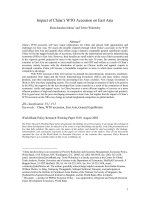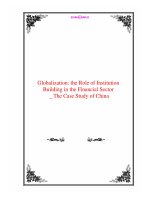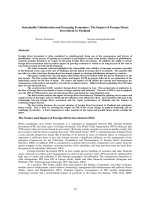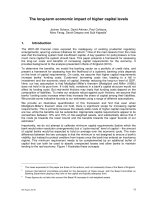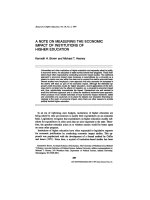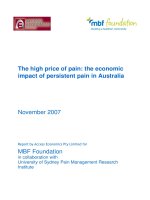The impact of china devalueing the yuan from 2015 2020
Bạn đang xem bản rút gọn của tài liệu. Xem và tải ngay bản đầy đủ của tài liệu tại đây (507.95 KB, 16 trang )
INTRODUCTION
The global economy has witnessed a series of trade disputes between
China and the US since January 2018, when the US government imposed
safeguard tariffs on many residential machines (Taylor & Francis, 2018). These
conflicts have engendered a full-fledged trade war.
On August 5, 2019, the People's Bank of China set the Yuan’s daily
reference rate below 7 per dollar for the first time in over a decade
(Investopedia, 2020). This, in response to new tariffs of 10% on $300 billion
worth of Chinese imports imposed by the Trump administration, set to go into
effect September 1st, 2019 (Investopedia, 2020). It is just the latest salvo in the
U.S. China trade war, but certainly not the first time China has devalued its
currency.
The U.S. Treasury Department officially named China a currency
manipulator on August 5th, 2019. It was the first time the U.S. had done so since
1984 (Investopedia, 2019). While mostly a symbolic move, the naming opens
the door for the Trump administration to consult with the International Monetary
Fund to eliminate any unfair advantage China's currency moves have given the
country (The Guardian, 2017).
This paper studies the current trade war between China and the US from
an action, that China devaluing the Yuan. By discovering about History of
China's currency devaluation (2015-2020), we reveal the reasons behind China's
currency devaluation, the key driver of the Trade war, and specially impact of
that act on Vietnam.
I.OVERVIEW OF CHINA DEVALUING THE YUAN
1.History Of China's Currency Devaluation (2015-2020)
Yuan/ Dollar Historical Chart (Macrotrends, 2020)
From Aug 11, 2015 to the end of 2016, Yuan devalued by 12 percent. On
August 11, 2015, the People’s Bank of China (PBOC) surprised markets with
three consecutive devaluations of the Yuan renminbi or Yuan (CNY), knocking
over 3% off its value. Since 2005, China’s currency had appreciated 33%
against the U.S. dollar, and the first devaluation marked the most significant
single drop in 20 years. While the move was unexpected and believed by many
to be a desperate attempt by China to boost exports in support of an economy
that was growing at its slowest rate in a quarter century, the PBOC claimed that
the devaluation was part of its reforms to move towards a more market-oriented
economy. The move had substantial repercussions worldwide. (Macrotrends,
2020)
From end of 2016 to Feb, 2018, RMB has appreciated by 9.4 percent
against the US dollar. (Macrotrends, 2020)
2
On August 5, 2019, the People’s Bank of China set the Yuan’s daily
reference rate below 7 per dollar for the first time in over a decade. Global
markets sold off on the move, including in the U.S. where the DJIA lost 2.9% in
its worst day of 2019 to date. (Investopedia, 2020)
2. Reasons behind China’s currency devaluation
Currency devaluation is nothing new. From the European Union to
developing nations, many countries have devalued their currency periodically to
help cushion their economies. However, China's devaluations could be
problematic for the global economy. Given that China is the world’s largest
exporter and its second-largest economy (Investopedia, 2019), any change that
such a large entity makes to the macroeconomic landscape has significant
repercussions. This part aims at providing information about the reasons why
China devalued its currency during this period.
2.1. This Is A Fact Consistent With The Market Fundamentals
Although a lower-valued Yuan does would give China somewhat of a
competitive advantage, trade wise (which will be explained in the next part), the
move was not totally counter market fundamentals. Over the past 20 years, the
Yuan had been appreciating relative to nearly every other major currency
including the U.S. dollar. Essentially, China’s policy allowed the market to
determine the direction of the Yuan’s movement while restricting the rate at
which it is appreciated (Investopedia, 2019). But, as China’s economy had
slowed significantly in the years prior to the devaluation while the U.S.
economy had improved. A continued rise in the Yuan’s value no longer aligned
with market fundamentals.
These actions, implemented by PBOC was a necessary adjustment rather
than a beggar-thy-neighbor(a term used for a set of policies that a country
enacts to address its economic woes that, in turn, actually worsens the
economic problems of other countries) (Adam Heyes, 2019) manipulation of the
exchange rate. While the drop in the value of the Yuan was the largest in two
3
decades, the currency remained stronger than it had been in the previous year in
trade-weighted terms.
2.2. This Will Pave The Way For China’s Exporting Products
Due to the low cost of the national currency, goods produced in China are
cheaper for foreign buyers. For example, if the Yuan fell by 5% against the
dollar, a laptop made in China would be 5% cheaper to purchase (Rufat Safarli,
2019). Moreover, if China devalues its currency to match US tariffs, then
American business partners will not have to overpay for Chinese goods.
In other words, by cheapening the Yuan, Beijing seeks to circumvent the
trade restrictions imposed by Donald Trump and keep exporting its goods to the
United States. Against this backdrop, the ambitions of Donald Trump to free the
domestic market from Chinese competitors and thereby stimulate the national
business, will be unsuccessful. However, controls on the currency have given
Chinese businesses a high degree of predictability when they plan investments
in industries heavily dependent on exports (The Guardian, 2017).
2.3. This Will Have Big Influence On IMF And China’s Desire To Become
The Reserve Currency
There was also another motive for China's decision to devalue the Yuan—
China's determination to be included in the International Monetary Fund's (IMF)
special drawing rights (SDR) basket of reserve currencies (the SDR is an
international reserve asset that IMF members can use to purchase domestic
currency in foreign exchange markets to maintain exchange rates). The IMF reevaluates the currency composition of its SDR basket every five years. In 2010,
the Yuan was rejected on the basis that it was not "freely usable.” But the
devaluation, supported by the claim that it was done in the name of marketoriented reforms, was welcomed by the IMF, and the Yuan did become part of
the SDR in 2016 ((Investopedia, 2019).
Within the basket, the Chinese renminbi had a weight of 10.92%
(Investopedia, 2019), which is more than the weights of the Japanese yen (JPY)
4
and U.K. pound sterling (GBP), at 8.33% and 8.09% (Investopedia, 2019),
respectively. The rate of borrowing funds from the IMF depends on the interest
rate of the SDR. As currency rates and interest rates are interlinked, the cost of
borrowing from the IMF for its 188 member nations would now hinge in part on
China's interest and currency rates.
II. THE KEY DRIVER OF THE TRADE WAR
1. The Impact Of China's Currency Devaluation On China - US Trade War
The China–United States trade war is an ongoing economic conflict
between the world's two largest national economies, China and the United States
(Wikipedia, 2019). In recent years, China has experienced rapid growth and
become a major economic power. For instance, China’s production volume now
ranks second worldwide, and China’s GDP has already surpassed the US in
purchasing power parity terms.
The competition between the two superpowers became increasingly stiff
in the context of American power with signs of deterioration while China is
revealing the ambition to replace the U.S. as a dominant position in world
geopolitical chessboard.
Earlier this month the US officially accused China of manipulating its
currency “to gain unfair competitive advantage in international trade”. China set
the value of its currency, the Yuan, to equal the value of a basket of currencies
that includes the dollar. China allowed the Yuan to fall below the 7:1 Yuan to
Dollar peg it has maintained since 2015, setting off a day of intense selling in
global markets. In the U.S., the Dow Jones Industrial Average fell 2.9% on
Monday, its worst daily decline all year. (Investopedia, 2019). In other words,
China pegged its currency to the dollar using a modified fixed exchange rate.
When the dollar lost value, China bought dollars through U.S. Treasurys to
support it. (Crsreports.congress.gov, 2019)
President Trump pressed the Federal Reserve to counter by pushing down
the dollar’s value and pushing up the RMB. Actually, the Treasury, not the Fed,
5
has authority over such actions but did not institute measures to do that.
(TheHill, 2019)
Later that day, the U.S. Treasury Department promptly labeled China a
"currency manipulator”. China disputed the charge accusing the US of
“deliberately
destroying
international
order”
with
“unilateralism
and
protectionism”. The International Monetary Fund (IMF) appears to be on
China’s side, arguing the devaluation of the Yuan is largely in line with
worsening economic conditions in China. (Rushe, 2019). Some believed that
China’s devaluation of the Yuan was just the beginning of a series of
competitive devaluations - a currency war - that could lead to increasing trade
tensions.
2. Scenario Development
The accusations of China's unfair trade practices are nothing new among
almost presidential debates before. However, just coming to the era of Trump,
has the issue been an official declaration of acquisition by the US Government.
Along with other factors, the consecutive Yuan’s devaluation has sparked
the trade war between the US and China since July 2018. The slide in value
comes as the U.S. and China remain locked in a trade dispute. As things stand,
the US has slapped tariffs on billions of US$ worth of Chinese products such as
steel and soy products and has threatened tariffs on many more billions.
In response to additional U.S. tariffs, China's central bank also weakened
the Yuan in the retaliation, following by tariffs of its own. Since then, the two
countries continued to threaten each other by releasing lists of proposed tariffs
on various goods. Also, there have been multiple rounds of talks between trade
representatives from the two nations taken place in both capitals Washington DC
and Beijing. But the steps on tariff escalation, on the other hand, fight against all
those efforts.
6
The US-China Trade war timeline(Source: Peterson Institute for International)
Economics (PIIE)
7
The chart above integrates the timeline of the US-China trade war with
key events of note occurring so far.
This chart was adapted from data available in Chad P. Bown's forthcoming blog
post, “Tariff worries remain after two years of the trade war and despite a
phase one deal.
Overall, the trade war has proceeded in five stages since early 2018:
The first six months of 2018 featured only a moderate increase in tariffs.
The months of July through September 2018 resulted in a sharp tariff
increase on both sides: US average tariffs increased from 3.8 percent to
12.0 percent, and China's average tariffs increased from 7.2 percent to
18.3 percent.
In stage three, there was an 8-month period (September 25, 2018, through
June 2019) of little change in tariffs.
From June to September 2019, another set of tariff increases kicked in.
In the current stage five, and despite the phase one agreement, tariffs
between the two countries remain elevated and are the new normal.(PIIE,
2020)
The settlement seemed to be hopeless until both the US and China have
thrown in the towel in terms of reaching a “Phase One” deal. This move is
considered to turn down the heat on their trade war.
Details of the agreement have emerged slowly. Last October, the White
House claimed that China agreed to significantly increase purchases of U.S.
agricultural goods. China has also promised to relax limits on foreign
investment in its financial sector, which would create opportunities for U.S.
investment banks to enter a growing market. In exchange, Trump slashed tariffs
on $112 billion worth of Chinese imports, lowering duties from 15 to 7.5
percent. He also suspended tariffs previously slated to hit another $160 billion in
Chinese goods. (TheHill, 2020)
8
Though very little has been said about intellectual property protections. Theft
of trade secrets was one of Trump’s primary justifications for his tough stance
on China. But a modest deal at this point may be better than no deal at all.
(TheHill, 2020)
With a lot of issues stated in the 86-page agreement, in terms of currency
problems, China and the United States also made certain commitments
regarding the operations of their central banks in foreign exchange markets.
They pledged not to engage allowing their currency values to fall so that goods
are cheaper. Also, a senior U.S. official said the currency rules would be
enforceable, meaning that a violation could be punished with more tariffs.
(POLITICO, 2020)
However, mentioning the case that Trump administration formally declared
China a currency manipulator this summer, many experts said at the time that
acquisition was unwarranted since China meets only the first of three criteria,
according to the Treasury's report on the currency manipulation topic in May
2019, even if China had unfairly devalued its currency in the past.
Therefore, it seems uncertain to make sure that the next dual currency-related
moves have enough evidence to bring out and come to the punishment part
according to the deal. A weakening currency itself can also spur capital outflows
from the wealthy seeking to protect their savings from devaluation. Such
outflows can be difficult to control, forming a feedback loop in which
downward pressure on a currency causes more selling, as more investors rush to
cash out of their investments.
In the end, these chains will create a vicious cycle following a falling
currency. That is a case interrupted by the external factors which can’t be
denied.
9
III. HOW CHINA'S CURRENCY MOVE AFFECTS VIETNAM
ECONOMY
1. That China Devalues The Yuan May Harm Vietnam’s Trade
As the trade war escalates, China has weakened its currency to boost
exports, making its goods even cheaper in Vietnam. The moves made Chinese
imports much cheaper, adding that Vietnam had to balance between controlling
the trade deficit and being able to compete with cheaper Chinese goods in the
market.
Vietnam, which heavily trades with China, will face greater trade deficit
risks after the Yuan was devalued, giving Chinese exports a significant
competitive edge, economists said. For many factors, previously, Chinese
exports were already cheap compared to those from other countries. The
devaluation will make them even cheaper, increasing their export market
competitiveness, including Vietnam.
China is Vietnam's top trading partner, but the world's second-largest economy
benefits more from the partnership. Vietnam exported $41.41 billion worth of
goods to China, but spent $75.45 billion on importing products from the
northern neighbor last year (General Department of Vietnam Customs, 2019).
Local products would fail to compete in the domestic market against cheap
Chinese goods.
Meanwhile, Vietnamese producers would find it harder to export their
products to China and other markets because of higher prices compared to
similar products originated from China. Business groups in the manufacturing,
mass production, textile and leather goods industries can import machinery from
China at a better price than they currently are, which could generate short-term
advantages. However, sustained business development is not foreseen in the
long term. (Thanhniennews, 2015)
The Government will have to decide either to devalue the Vietnamese
đồng further against the US dollar to support exports and avoid cheaper Chinese
goods to flood in the local market, or keep the dollar/đồng exchange rate stable
10
to avoid increased public debt and control inflation as the US-China trade war
accelerates.
2. Vietnam Acts With Composure
While businesses believe it is important to devalue the dong just like
other countries did with their currencies, economists agree with Vietnam's State
Bank that the fall in the value will not bring the desired results.
Nguyen Bich Lam, general director of the General Statistics Office (GSO). said
at a press conference in late September that the devaluation of the dong may
bring ‘reverse effects’. (Vietnamnet, 2019)
Several firms have urged State Bank of Vietnam (SBV) to devalue the
Vietnam dong in order to boost exports which have been moving slower. The
exchange rate, however, isn't just the method used to accelerate exports. The
question of imports also needs to be considered. The imports will become more
costly once the local currency loses its value.
So far this year, many countries around the world have devalued the local
currencies in an effort to limit the trade war's effects. In the meantime the value
of Vietnam's dong was stable. Only Vietnam dong and Thailand baht remain
stable in ASEAN, or have appreciated against the dollar in the context of the
Chinese Yuan's continued depreciation.
Chief economist of BIDV Can Van Luc said the currency used in payment
remains the US dollar, while the prices of contracts were fixed. When the
Chinese Yuan depreciates and the dollar value increases, Vietnamese enterprises
will get bigger benefits when converting from the US dollar into Chinese Yuan.
Since it is difficult to predict the next happenings of the US-China trade war, it
is impossible to say about the impact on Vietnam businesses’ operations in the
medium and long term. Luc advised enterprises to keep close watch over the
situation and the assessments about exchange rate risks. Some commercial
banks have slashed the lending interest rates since August 1, 2019. Dinh Quang
Hinh from VnDirect Securities commented that banks have taken flexible moves
in accordance with market fluctuations, suitable to Vietnam’s conditions.
However, the interest rate reductions have been applied only at some banks
11
which have capital, but this is not common in the banking system.
(Vietnamnet,2019)
Although the SBV may be under pressure to depreciate, the SBV will take
measures to prevent the VND from devaluating too deeply (over 3%) to avoid
the risk of US “currency manipulator” listing because of VND has been
devalued in the recent years. (VOV, 2019)
Vietnam exchange rate against USD(Focus Economics, 2017)
It would be hard to achieve the nation’s target of keeping inflation below
4 percent this year, not to mention other factors such as higher oil prices and
natural disasters. If Vietnam decided to move forward with devaluing the dong,
the adjustments should be based on market demand and not on the Yuan’s value.
12
CONCLUSION
Currency devaluation is nothing new. From the European Union to
developing nations, many countries have devalued their currency periodically to
help
cushion
their
economies.
However,
China's
devaluations
could
be problematic for the global economy. Given that China is the world’s largest
exporter and its second-largest economy, any change that such a large entity
makes to the macroeconomic landscape has significant repercussions.
With Chinese goods becoming cheaper, many small- to medium-sized
export-driven economies could see reduced trade revenues. If these nations are
debt-ridden and have a heavy dependence on exports, their economies could
suffer. For instance, Vietnam, Bangladesh, and Indonesia greatly rely on their
footwear and textile exports. These countries could suffer if China's
devaluations make its goods cheaper in the global marketplace.
China's justification for devaluing the Yuan in 2015 was the rise of the
U.S. dollar, and the country's desire to shift to domestic consumption and
service-based economy. While fears of further devaluations continued on the
international investment scene for another year, they faded as China's economy
and foreign exchange reserves strengthened in 2017. However, China's recent
moves in 2019 will continue to send ripples across global financial systems, and
rival economies should brace themselves for the after-effects.(Investopedia,
2020)
13
REFERENCE
1.
Taylor & Francis. (2020). Understanding the China–US trade war:
causes, economic impact, and the worst-case scenario. [online] Available at:
/>[Accessed 5 Mar. 2020].
2.
Investopedia. (2020). The Impact of China Devaluing the Yuan. [online]
Available at: />[Accessed 5 Mar. 2020].
3.
Investopedia. (2019). The U.S. Labels China a Currency Manipulator.
[online] Available at: [Accessed 5 Mar. 2020].
4.
The Guardian, 2017. Why has China devalued its currency and what
impact will it have?. [online] Available at:
[Accessed 1 March 2020]
5.
Macrotrends.net. (2020). Dollar Yuan Exchange Rate - 35 Year Historical
Chart. [online] Available at: [Accessed 6 Mar. 2020].
6.
INVESTOPEDIA, 2019. The impact of China devaluing the Yuan.
[online] Available at: [Accessed 1 March 2020].
7.
Adam Hayes, Oct 24, 2019. Beggar-Thy-Neighbor. [online] Available at:
[Accessed 1
March 2020]
8.
Rufat Safarli, 2019. Why is China devaluing its currency?. [online]
Available at: [Accessed 1 March 2020]
14
9.
The Guardian, 2017. Why has China devalued its currency and what
impact will it have?. [online] Available at:
10.
/>
against-us-dollar-explainer
11.
[Accessed 1 March 2020]
12.
Investopedia. (2019). The U.S. Labels China a Currency
Manipulator. [online] Available at: />[Accessed 7 Mar. 2020].
13. Crsreports.congress.gov. (2019). [online] Available at:
[Accessed 25 Feb.
2020].
14. Rushe, D. (2019). Here are the reasons for Trump's economic war
with China. [online] the Guardian. Available at:
[Accessed 25 Feb. 2020].
15. HORMATS, R. (2019). US-China trade war risks becoming a
currency war — with greater damage. [online] Available at:
[Accessed 7 Mar. 2020].
16.
POLITICO. (2020). Here’s what’s in, what’s out of U.S.-China trade deal.
[online] Available at: [Accessed 25 Feb. 2020].
17.
TheHill. (2020). An imperfect US-China deal may be better than no deal
at all. [online] Available at: [Accessed 25 Feb.
2020].
18.
PIIE. (2020). US-China Trade War Tariffs: An Up-to-Date Chart. [online]
Available at: [Accessed 25 Feb. 2020].
15
19.
Anon, (2020). [online] Available at:
[Accessed 25 Feb. 2020].
20.
Thanh Nien News. (2015). China's currency devaluation will hit Vietnam
really hard: economists. [online] Available at:
[Accessed 25 Feb. 2020].
21.
VOV - ĐÀI TIẾNG NÓI VIỆT NAM. (2019). Trung Quốc phá giá đồng
Nhân dân tệ, Việt Nam bị ảnh hưởng như thế nào?. [online] Available at:
[Accessed 25 Feb. 2020].
22.
VietNamNet. (2019). Vietnam will not use exchange rate as tool to boost
exports: central bank - VietNamNet. [online] Available at:
[Accessed 25 Feb. 2020].
16
